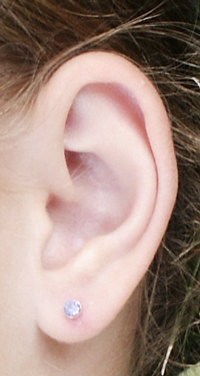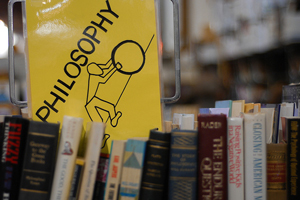
Source: Put it together, Eric, Flickr

Source: Studearring, Earpiercing, Wikimedia
We have been investigating how the words used today relate to those used hundreds of years ago. How is it that an audible sound, for example, can be heard while an inaudible sound cannot? What is it in the way the words are formed that makes it so? Why do we only listen to an audiotape while we use sight and hearing with videotape? The answer lies in the subject of this lesson: using roots and affixes to determine the meaning of words.
The word audible, if unfamiliar to you, can be figured out by—you guessed it—dividing it into its root and affixes. The root audi is Latin for “hear” or “listen,” and the suffix -ible is Latin for “able to.” If you put it together, you arrive at the following meaning:
audi (hear) +-ible (able) = audible (able to be heard)

Source: Auditorium - quartier Siam - centre ville (Brest), ADEUpa Brest, Flickr
Using this strategy, can you find the meaning for the following related words? Once you have a definition in mind, mouse over each one.
inaudible auditorium audiologist audiophile
Let’s say you come across the word pugnacious in your reading, and you’re at a loss for its meaning. You could use a dictionary, consult your teacher or a classmate, or examine the context for clues to the meaning of pugnacious. However, from your study of roots and affixes, you remember or you discover that the Latin word for fighting is pugno. Maybe the new word pugnacious has something to do with fighting. You already know that -cious means full of, so maybe pugnacious means full of fight, or describes someone who wants to fight. When I read it in context, I see that it could work.
Voilà! From now on whenever you run into the word pugnacious (or any word with the root pugna), whether it’s during the course of your reading, or in the context of a lecture or speech or even during conversation, you will know what it means right away or have the ability to figure it out.

Source: Philosophy is hard, Keoki Seu, Flickr
Now, let’s practice using your knowledge of roots and affixes and your ability to break unfamiliar words into chunks to make meaning of new words. In the passage below, your job is to read, then reread and pay attention to the words in italics. Next, see if you can figure out the word meanings by dividing them into roots and affixes, keeping in mind that there may be more than one affix in each word. Use the context clues found in the surrounding text to help with your understanding. The first two questions have been answered for you. Read the questions and the answers provided so you can get the hang of this activity.
(1) We walked through the busy downtown streets until we came to a shop. (2) On top of the building, adjacent to the huge plateglass window, was a large sign that spelled out in green and white letters “Bennie’s Italian Market.” (3) There, amid the cheeses and salted meats, I met an incredible man.
(4) A short, balding man waited on me. (5) I guessed that he was the owner—and presumably the baker—of the shop. (6) He stood behind the counter, the top of the glass display case hiding all but the top of his round head. (7) He smiled, his sweaty face beaming into mine. (8) It was a calm, clean-shaven face. (9) I later learned that this ordinary little man was the philosopher who would bring an end to my long journey.

1. In sentence number 2, the word adjacent means—
b. “next to”
Answer: Break the word into the affix ad-, meaning “next to,” and the root of the word, jacent, from the Latin meaning “lie.” The text talks about the sign being at the top of the building. You can imagine that the big shop window is big enough to reach it. Adjacent refers to something that is lying next to something else.
2. In sentence number 3, the word amid means—a. “in the middle of”
Answer: Break the word into the affix a-, meaning “on,” and the root mid, meaning “middle.” The author writes about the merchandise in the shop and mentions the man in the nearby text. Amid refers to something in the middle of or in the midst of.
3. In sentence number 3, the word incredible means—b. “not able to be believed”
b. “ready to continue”
b. “a person who loves/studies wisdom”
Now, study the list of Greek and Latin prefixes, suffixes, and roots in the interactive exercise below. Then use your knowledge of ancient languages to drag and drop each affix or root below to match the hint in the left-hand column.

Your newfound knowledge of roots and affixes and how they help form the words we use today will help you figure out the meanings of words. Who knows? You might even become as powerful as Root Man!